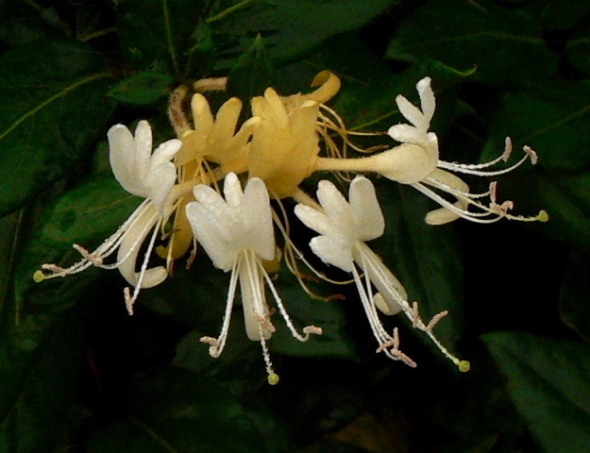Honeysuckle Extract ~ Japanese Honeysuckle: Lonicera japonica

Other Names Chin Yin Hua, Chin Yin T’Eng, Honeysuckle, Japanese Honeysuckle, Jen Tung, Jen Tung Chiu, Jen Tung Kao, Sui-Kazura, Yin Hua, Hall’s Honeysuckle, White honeysuckle, Chinese honeysuckle, Halliana
Habitat
Perennial herb Native to E. Asia – China, Japan, Korea, now naturalized in Britain and the US from southern New York and New Jersey south to southern Florida and west to southwestern Texas. Inland it is distributed from Pennsylvania and West Virginia west to Missouri, Kansas, and Oklahoma. Widespread in the eastern and southern United States. Japanese honeysuckle is an important white-tailed deer food and is often invasive.
Cultivation: prefers partial shade to full sun and moist soil. Prune back hard in winter to prevent the build-up of woody growth, provide a trellis. Climbing Vine, Shrub, it has a dense root system that may extend laterally for a distance of 7 to 10 feet, and attain depths of 3 to 4 feet. The simple, opposite, pinnate leaves are oval to oblong in shape and are semi-evergreen and may persist on vines year-round, up to 3 inches in length. The extremely fragrant, two-lipped flowers are borne in pairs in the axils of young branches and are produced throughout the summer. Flowers range from 1 to 2 inches in length and are white with a slight purple or pink tinge when young, changing to white or yellow with age, they are edible. The fruit is a black, berrylike drupe with three to five one-seeded stones. (See harvest times for various parts of the plant below).
Properties
Japanese honeysuckle is edible and medicinal. High in Calcium, Magnesium, and Potassium, the leaves can be parboiled and eaten as a vegetable. The edible buds and flowers, made into a syrup or puddings. The entire plant has been used as an alternative medicine for thousands of years in Asia. The active constituents include calcium, elaidic-acid, hcn, inositol, linoleic-acid, lonicerin, luteolin, magnesium, myristic-acid, potassium, tannin, and zink. It is alterative, antibacterial, antiinflammatory, antispasmodic, depurative, diuretic, febrifuge, and is also used to reduce blood pressure. The stems are used internally in the treatment of acute rheumatoid arthritis, mumps and hepatitis.
The stems are harvested in the autumn and winter, and are dried for later herb use. The stems and flowers are used together a medicinal infusion in the treatment of upper respiratory tract infections (including pneumonia) and dysentery. An infusion of the flower buds is used in the treatment of a wide range of ailments including syphillitic skin diseases and tumors, bacterial dysentery, colds, and enteritis. Experimentally, the flower extracts have been shown to lower blood cholesterol levels and are antibacterial, antiviral and tuberculostatic. Externally, the flowers are applied as a medicinal wash to skin inflammations, infectious rashes and sores. The flowers are harvested in early morning before they open and are dried for later herb use. This plant has become a serious weed in many areas of N. America, it might have the potential to be utilized for proven medicinal purposes. Other uses include; Ground cover, Insecticide, Basketry, vines used to make baskets. The white-flowers of cultivar ‘Halliana’ has a pronounced lemon-like perfume.
How to Make Honeysuckle Extract
-
- 1
Purchase 80 to 100 proof brandy or vodka. This proof will ensure a good balance of alcohol and water in the final extract as opposed to a higher-proof alcohol.
- 2
Calculate how many honeysuckle flowers you will need. Herbal extracts can be tricky to make with fresh material because of the guesswork in deciding how much liquid the petals contain. In general, use 1 part fresh plant material to 2 parts alcohol. In practice, 4 oz. (dry weight) of honeysuckle flowers would require 8 oz. (liquid measure) alcohol.
- 3
Pick the honeysuckle flowers. The buds, stems and opened flowers all contain special properties.
- 4
Fill a glass jar loosely with the honeysuckle flowers.
- 5
Pour the alcohol over the flowers, making sure to saturate all the plant material.
- 6
Securely cap and set the jar to steep in a dark place for two to six weeks.
- 7
Label the jar with the date the extract was made and the ingredients.
- 8
Shake the honeysuckle extract as often as possible during the steeping process.
- 9
Uncap the mixture after it has steeped for the proper period of time.
- 10
Strain the liquid through cheesecloth, firmly squeezing the cheesecloth to release all the extract.
- 11
Decant into small bottles or vials with tight stoppers or corks.
- 12
Make a new label, again noting the date when it was decanted, the contents and dosing recommendations.
- 13
Store in a cupboard or refrigerator.
- 14
Take when needed at a dose of five to 15 drops per 8 oz. glass of water or orange juice.
- 1
Tips & Warnings
- Honeysuckle extracted with other mediums can also be used therapeutically. Steep the flowers in olive, sweet almond or jojoba oil for massage oil to help increase circulation in the hands and feet, according to “The Complete Book of Herbs.”
- Rose recommends honeysuckle flower syrup as an effective gargle for sore throats. Make your favorite simple syrup recipe, but replace plain water with water in which fresh honeysuckle flowers, or honeysuckle tea, has been infused in simmering water for 10 minutes.
- If you can’t tolerate alcohol-based medicines, substitute the same amount of vinegar for the brandy or vodka.
- Consult with your doctor before trying any herbal remedies.







Leave a comment